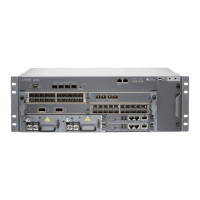Table 16: Management LEDs
DescriptionStateColorLocationName
1000-Mbps link is online.OnGreenLeftLink
100-Mbps link is online.OnYellow
10-Mbps link is online.Off–
The port is receiving data.BlinkingYellowRightActivity
The port is not receiving data.Off–
MX104 Boot Sequence
The MX104 router ships with Junos OS preinstalled and ready to be configured when the
router is powered on. One eight-GB internal NAND Flash memory (da0) acts as the hard
drive. Two USB ports on the front panel accept USB storage devices (usb0 and usb1)
that can also function as alternative boot devices.
When the router boots, it first attempts to start the image on the USB 0 flash memory
device, if present, then attempts to start the image on the USB 1 flash memory device, if
present. If a USB flash memory device is not inserted into either of the two slots on the
Routing Engine, or the attempt otherwise fails, the router next tries the active partition
on the NAND Flash device.
Related
Documentation
Maintaining the MX104 Routing Engines on page 192•
• Replacing an MX104 Routing Engine on page 152
MX104 Routing Engine Overview
The Routing Engine is a Freescale-based PC platform that runs Junos OS. Software
processes that run on the Routing Engine maintain the routing tables, manage the routing
protocols used on the router, control the router interfaces, control some chassis
components, and provide the interface for system management and user access to the
router.
You can install one or two Routing Engines in the router. The Routing Engine installs into
the front of the chassis. Two USB ports on the Routing Engine accept a USB memory
card that allows you to load Junos OS.
If two Routing Engines are installed, one functions as the master and the other acts as
the backup. If the master Routing Engine fails or is removed and the backup is configured
appropriately, the backup takes over as the master. The backup Routing Engine is
hot-insertable and hot-removable.
The MX104 router supports the Routing Engine with model number RE-MX104.
27Copyright © 2017, Juniper Networks, Inc.
Chapter 4: Host Subsystem Components and Descriptions

